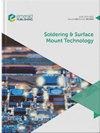Detection of solder paste defects with an optimization‐based deep learning model using image processing techniques
IF 1.7
4区 材料科学
Q3 ENGINEERING, ELECTRICAL & ELECTRONIC
引用次数: 62
Abstract
Purpose In the production processes of electronic devices, production activities are interrupted due to the problems caused by soldering defects during the assembly of surface-mounted elements on printed circuit boards (PCBs), and this leads to an increase in production costs. In solder paste applications, defects that may occur in electronic cards are usually noticed at the last stage of the production process. This situation reduces the efficiency of production and causes delays in the delivery schedule of critical systems. This study aims to overcome these problems, optimization based deep learning model has been proposed by using 2D signal processing methods. Design/methodology/approach An optimization-based deep learning model is proposed by using image-processing techniques to detect solder paste defects on PCBs with high performance at an early stage. Convolutional neural network, one of the deep learning methods, is trained using the data set obtained for this study, and pad regions on PCB are classified. Findings A total of six types of classes used in the study consist of uncorrectable soldering, missing soldering, excess soldering, short circuit, undefined object and correct soldering, which are frequently used in the literature. The validity of the model has been tested on the data set consisting of 648 test data. Originality/value The effect of image processing and optimization methods on model performance is examined. With the help of the proposed model, defective solder paste areas on PCBs are detected, and these regions are visualized by taking them into a frame.使用图像处理技术的基于优化的深度学习模型检测锡膏缺陷
目的在电子器件的生产过程中,由于印刷电路板(pcb)表面贴装元件组装过程中出现的焊接缺陷问题,导致生产活动中断,导致生产成本增加。在锡膏应用中,电子卡中可能出现的缺陷通常在生产过程的最后阶段才被注意到。这种情况降低了生产效率,并导致关键系统的交付进度延迟。本研究针对这些问题,采用二维信号处理方法,提出了基于优化的深度学习模型。设计/方法/方法提出了一种基于优化的深度学习模型,利用图像处理技术在早期阶段检测高性能pcb上的锡膏缺陷。利用本研究获得的数据集对深度学习方法之一的卷积神经网络进行训练,并对PCB上的垫区进行分类。研究中共使用了六种类型,包括文献中经常使用的不可纠正焊接、缺失焊接、过量焊接、短路、未定义对象和正确焊接。在由648个测试数据组成的数据集上对模型的有效性进行了检验。研究了图像处理和优化方法对模型性能的影响。在提出的模型的帮助下,检测pcb上有缺陷的锡膏区域,并将这些区域放入框架中进行可视化。
本文章由计算机程序翻译,如有差异,请以英文原文为准。
求助全文
约1分钟内获得全文
求助全文
来源期刊

Soldering & Surface Mount Technology
工程技术-材料科学:综合
CiteScore
4.10
自引率
15.00%
发文量
30
审稿时长
>12 weeks
期刊介绍:
Soldering & Surface Mount Technology seeks to make an important contribution to the advancement of research and application within the technical body of knowledge and expertise in this vital area. Soldering & Surface Mount Technology compliments its sister publications; Circuit World and Microelectronics International.
The journal covers all aspects of SMT from alloys, pastes and fluxes, to reliability and environmental effects, and is currently providing an important dissemination route for new knowledge on lead-free solders and processes. The journal comprises a multidisciplinary study of the key materials and technologies used to assemble state of the art functional electronic devices. The key focus is on assembling devices and interconnecting components via soldering, whilst also embracing a broad range of related approaches.
 求助内容:
求助内容: 应助结果提醒方式:
应助结果提醒方式:


